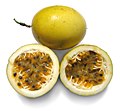Passion fruit (fruit)

The passion fruit (Portuguese: maracujá and Spanish: maracuyá, both from the Tupi mara kuya "fruit that serves itself" or "food in a cuia") is the fruit of a number of plants in the genus Passiflora.[1][2]
Description
Passion fruits are
History
The passion fruit was first introduced to Europe in 1553.[3]
Etymology
Maracujá
The Portuguese maracujá and Spanish maracuyá are both derived from the Tupi mara kuya "fruit that serves itself" or "food in a cuia".
Passion fruit
The term 'passion fruit' in English comes from the
Varieties

Well known edible passion fruits can be divided into four main types:
- purple passion fruit (fruits of Passiflora edulis Sims),
- yellow passion fruit (Passiflora edulis f. flavicarpa Deg.),
- sweet granadilla (Passiflora ligularis),
- giant granadilla (Passiflora quadrangularis L.).[6]
Uses
The fruits have a juicy edible center composed of a large number of seeds.[1] The part of the fruit that is used (eaten) is the pulpy juicy seeds. Passion fruits can also be squeezed to make juice.[1] It is also used in pastries and other baked products.
Composition
Nutrition
| Nutritional value per 100 g (3.5 oz) | |
|---|---|
| Energy | 406 kJ (97 kcal) |
23.4 g | |
| Sugars | 11.2 g |
| Dietary fiber | 10.4 g |
0.7 g | |
2.2 g | |
Niacin (B3) | 9% 1.5 mg |
| Vitamin B6 | 6% 0.1 mg |
| Folate (B9) | 4% 14 μg |
| Choline | 1% 7.6 mg |
| Vitamin C | 33% 30 mg |
| Vitamin K | 1% 0.7 μg |
| Minerals | Quantity %DV† |
| Calcium | 1% 12 mg |
| Iron | 9% 1.6 mg |
| Magnesium | 7% 29 mg |
| Phosphorus | 5% 68 mg |
| Potassium | 12% 348 mg |
| Sodium | 1% 28 mg |
| Zinc | 1% 0.1 mg |
| Other constituents | Quantity |
| Water | 72.9 g |
| †Percentages estimated using US recommendations for adults,[7] except for potassium, which is estimated based on expert recommendation from the National Academies.[8] | |
Raw passion fruit is 73% water, 23%
are in significant content.Phytochemicals
Several varieties of passion fruit are rich in polyphenols,[9][10] and some contain prunasin and other cyanogenic glycosides in the peel and juice.[11]
Gallery
-
Purple passion fruit (Passiflora edulis)
-
Yellow passion fruit (Passiflora edulis f. flavicarpa)
-
Passiflora ligularis fruit
-
Red, yellow, and green Passiflora edulis
-
Giant granadilla (Passiflora quadrangularis L.)
-
Unripe common passion fruit
See also
References
- ^ a b c d e f Morton JF (1987). "Passionfruit, p. 320–328; In: Fruits of Warm Climates". NewCrop, Center for New Crops and Plant Products, Department of Horticulture and Landscape Architecture at Purdue University, W. Lafayette, Indiana. Retrieved 22 January 2020.
- ISBN 978-1-4020-6738-9.
- ^ "HS1406/HS1406: The Passion Fruit in Florida". edis.ifas.ufl.edu. Retrieved 2022-02-17.
- ^ ISBN 978-0191040726.
- ^ "Origin of the Name Passionfruit".
- ISBN 978-0-08-053087-1.
- ^ United States Food and Drug Administration (2024). "Daily Value on the Nutrition and Supplement Facts Labels". Retrieved 2024-03-28.
- )
- PMID 12568552.
- PMID 23027609.
- .






